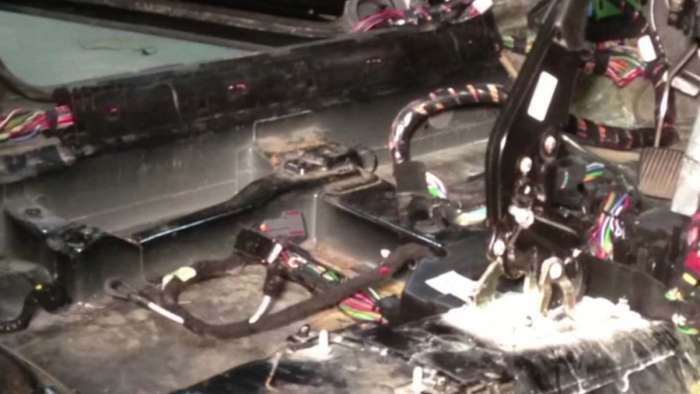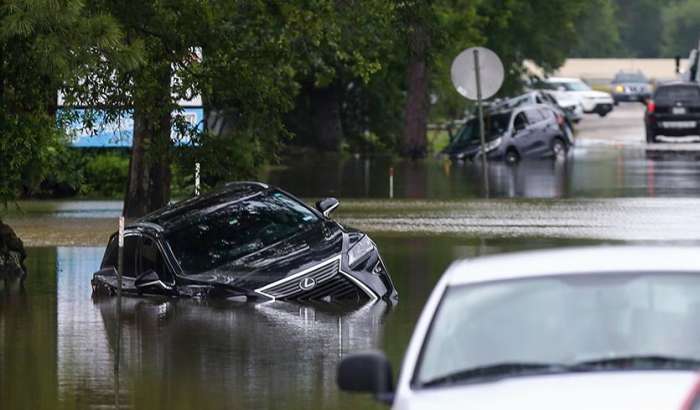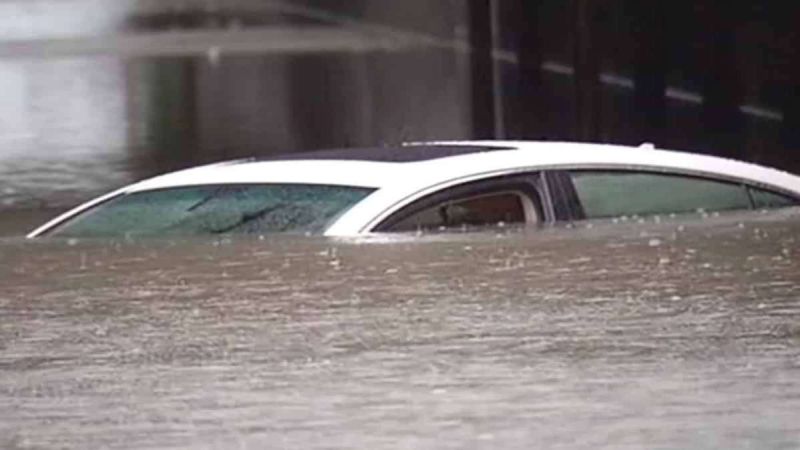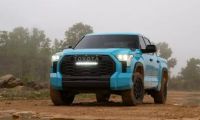 The photos were stark. After Hurricane Ida tore her way through the country, leaving devastation in her wake with houses flooded or destroyed and lines of vehicles submerged. The surrounding floodwaters ranged from salt water to brackish brine to freshwater.
The photos were stark. After Hurricane Ida tore her way through the country, leaving devastation in her wake with houses flooded or destroyed and lines of vehicles submerged. The surrounding floodwaters ranged from salt water to brackish brine to freshwater.
In today's story, Torque News and Consumer Reports analyze flood cars and trucks and what you can do to check. It is a piece that I present here.
Submerging Destroys Vehicles
The fact that they were submerged destroyed these vehicles. It's true. After their dunkings, they should disappear from the country's automotive fleet. But, many times, they reappear. Indeed, it doesn't mean these flooded vehicles won't return to the market some months from now.
Usually, flood cars will drift out of the flooded areas, emerging in other areas far from their original locations where they may end up on the sales block. Are they supposed to be sold? The answer is simple – no. Indeed, when a vehicle floods, it changes immediately or is supposed to change immediately. The critical change is the type of title.
When a vehicle floods, the title changes. Immediately, the title changes from clear to salvage. The salvage title is supposed to remain with the vehicle. You can't resell a salvaged vehicle. Yet, somehow many salvage vehicles end up for sale with rebuilt, clear titles.
And, with today's shortage of used cars, unscrupulous dealers know that if they put these vehicles back into circulation, buyers will snap up what they perceive to be great deals. Are they good buys? For many reasons, they are not.
While flood cars may look like great deals, they are not, as we explain. Jimmy Dinsmore explains why Mustang Mach-E models are torure-tested.
Unscrupulous Dealers Go To Lengths
When offered for sale in other parts of the country, flood cars look great. Unscrupulous dealers go to some lengths to get these vehicles back into circulation. These dealers often don't think of themselves as unscrupulous. They believe they are performing a needed service. They take delivery of large numbers of these vehicles, letting them dry out with their doors open, often waiting for weeks until they believe they can offer for sale. These vehicles are available to dealers for cents on the dollar while they end up selling them for nearly full used prices.
It is especially true now as there is a shortage of used vehicles. Flood cars may look like great deals, but they are not.
Everyone has seen the images I described earlier. A couple of weeks ago, the images appeared very regularly following the hurricane Ida and now tropical storm Nicholas. There were images of vehicles lined up in parking lots. They were left there by their owners in the apparent hope that they would be all right. They were all right, too, until the storm surge hit or until levees were topped and the vehicles flooded. There were also images of vehicles left in the middle of the road, water up over their window lines, abandoned by fleeing drivers. These vehicles often sit in the middle of the road after the water goes down and, if they have been sitting in freshwater, they are taken out of an area and sold 10 states away.
They are far from a great deal. With today's vehicles and electronics, it is possible that, even if they are dried out, their electronics will fail as corrosion and mold eat at the electronic connections. The same is true of the wiring. Vehicles don't use waterproof wiring. Instead, they use coated wiring that is often pretty messy on the side as the wire is shorting out.
Items like vehicle displays are unusually susceptible to moisture. And, even if someone makes an effort to dry infotainment electronics and connections, they are likely to be failures. Sure, the display may come up for a month or two, but when it goes down, it is gone. And, there is no warranty – despite what you may think – that will cover these parts.
On a more conventional note, there is no good way to dry out a submerged vehicle's carpeting, seating, upholstery, interior panels, and headliner. Sure, it may seem that all one has to do is open the doors and windows and let a vehicle dry out. But, when you get into the vehicle after it is dried, you will find that mold is a big problem. Another big problem is that you cannot adequately dry out a vehicle's interior, no matter what.
Best Thing To Do Is Give Flood Car Wide Berth
The best thing that one can do with a flood car is give it a wide berth. How do you know if a vehicle you are thinking of buying is a flood car? There are several telltales.
The first is the sniff test. It may seem silly to put it this way. Still, when you think about a flood car, you have to remember that the vehicle has been in several feet of water which contains quite a chemical stew. The drying process never really gets rid of a vehicle's odors. You have to be aware that dealers have various powerful cleaners that may or may not mask an odor for a while. Ultimately, though, the odors will win out, and you will have a very odorous and unusable vehicle.
The second is the visual check. Look carefully at the interior. Pull up the carpeting and look for muck underneath. It is something that unscrupulous dealers ignore in their quests for quick money. Dealers of these vehicles want you to buy right away before the guy who just called them scoops up the honey of a vehicle on the lot. If a dealer balks at letting poke around the interior, give the vehicle and the sales lot very wide berths.
Carpeting is only the start of your visual check. Put your hand into the seam between the seat bottom and the seatback. You will likely feel sand, gravel, or muck dried in the seam. If you do, walk away. Do something as simple as opening the glove box and checking if there might be residue at the bottom. The same is true of any interior panel. If you can lift a panel, check around the door bottom for muck that may be there. You may also find an odor starting in this area, no matter how powerful the cleaning agent is.
Here's a good check that not many dealers think you will check, and that is putting your hand under the dash panel and feeling around. The chances are good that you will find residue there, too.
Does it sound like I am raining on what a dealer will tell you is a great deal – especially today, given the shortage of top-quality used vehicles? Well, you are right I am. It's because I have seen and worked on flood cars myself that I know this. Indeed, it is beyond the warnings that publications like Consumer Reports will discuss. The reason is not that they haven't seen these problems or issues. It is because they don't have the resource to check every flood car out there. And, frankly, neither does Torque News.
A Tale Of A Real Dealership
However, I was asked by a dealership where I was the online sales manager to look over a high-line vehicle that seemed to be too good a deal to be real. Once I had gone through the vehicle closely, I found out that it was too good to be true.
The story behind the vehicle is simple. A used-car manager at one of our associated stores saw what he believed to be a good value and bid online. He won the bid, and the seller shipped the vehicle in anticipation of being paid. It didn't turn out that way.
On the surface, everything looked fine – though the brand new title paper should have been a giveaway. Indeed, the vehicle looked great. It was well detailed, washed, and waxed. It seemed great.
However, when they took the vehicle out for a test spin, it stopped in the middle of traffic. Fortunately, the traffic was very slow-moving rush-hour traffic. Otherwise, the crew testing the car might have been injured.
They did get the vehicle restarted, and straightaway, they put it up on a lift. At this point, a mechanic went through the vehicle is all he did was shake his head. They then asked me to look things over and document many of the issues with images – part of my online management job was putting images of used vehicles on our website.
I spent a couple of hours looking over the undercarriage of the vehicle. Honestly, it was effortless finding the problems because it looked like high water at a beach. As I looked at the vehicle, I noticed a buildup of sand and dirt on the upper side of the transmission. The layer of sand and dirt continued on the exhaust system. It also coated the front and rear suspension members.
Sand And Dirt Shouldn’t Have Been There
Suffice to say, it shouldn't have been there. And, it shouldn't have been inside the wheel covers. Indeed, the wheel covers sounded like tambourines, rather noisy ones, at that.
After surveying all the layers of sand and dirt and documenting it with many photos, I wrote a memo to the used-car sales manager. In the memo, I suggested returning the vehicle. I would have suggested asking for a refund. However, there was no need as the owner of the dealership stopped the wire transfer.
As I went through the vehicle, I noticed the upholstery seemed brand new – not worn at all. It was a real giveaway because used vehicles should have worn spots where the driver slid in, and the former owner rested his foot or braked. Yes, the brake pedal and accelerator looked worn upholstery was too new. There was no wear.
That was only one giveaway. When I pulled out the rear seat and looked around, another small beach-worth of sand was sitting there. Though the front seat area looked new and clean – it had been detailed very nicely. When I had a chance to get under the front seat, there was more sand and muck. We had had the vehicle on the lift for more than a couple of days by this time. When we brought it down, there was more than a hint of dampness and mustiness.
The obvious moral for this particular story is that even though a vehicle looks great if it has been left in the water for any time, no matter how well it is dried out and cleaned, it should be salvaged, not sold.
Remember, at this point, that this vehicle should have been declared salvage. The title should now read SALVAGE. It means the vehicle cannot be sold. It is no longer a consumer item. The vehicle can go to an auto salvage yard to be cut down and parted out piecemeal.
Somehow A New Title Appeared
Yet, somehow, a new title appeared. It was clean. It was also brand new, which should have been a giveaway, as well. Now, I can only guess how a salvage title can have been rebuilt into a clean title. As I noted, the vehicle had a brand spanking new title.
Here's noting that the dealer from whence the vehicle came did expect payment. As I noted, the owner stopped the wire transfer, and we set the return of the vehicle. As we rejected the unit, it was headed back to its origination site on the other guy's dime.
So, what does this have to do with flood cars? It is obvious. The vehicle that came through the dealership was flood-damaged. It indeed looked like a great deal. Indeed, the internet person at the other end put together a very nice description. The deal looked terrific. That stopped once the mechanic went through the vehicle, and I did the documentation. It was almost an expensive lesson learned. Yes, even dealerships can find themselves with flood cars.
As noted, flood cars usually end up many states away from their origins. They move through auctions or online sales pitches. They are vehicles to be avoided. Yet, given the very tight market for late-model used cars and SUVs, many unscrupulous dealers will try to recycle the vehicles that should be destroyed. The many flood cars that insurance companies automatically total will have their titles rebuilt. They will be foisted on unsuspecting customers who only want newer vehicles. Unfortunately, they are flood cars that will break, probably soon after they leave their sales lots.
Consumer Reports On Flood Cars
In the next part of this story, the editors of Consumer Reports will give their assessments and tell you what not to do with flood cars.
 Marc Stern has been an automotive writer since 1971 when an otherwise normal news editor said, "You're our new car editor," and dumped about 27 pounds of auto stuff on my desk. I was in heaven as I have been a gearhead from my early days. As a teen, I spent the usual number of misspent hours hanging out at gas stations Shell and Texaco (a big thing in my youth) and working on cars. From there on, it was a straight line to my first column for the paper, "You Auto Know," an enterprise that I handled faithfully for 32 years. Not many people know that I also handled computer documentation for a good part of my living while writing YAN. My best writing, though, was always in cars. My work has appeared in Popular Mechanics, Mechanix Illustrated, AutoWeek, SuperStock, Trailer Life, Old Cars Weekly, Special Interest Autos, and others. You can follow me on: Twitter or Facebook.
Marc Stern has been an automotive writer since 1971 when an otherwise normal news editor said, "You're our new car editor," and dumped about 27 pounds of auto stuff on my desk. I was in heaven as I have been a gearhead from my early days. As a teen, I spent the usual number of misspent hours hanging out at gas stations Shell and Texaco (a big thing in my youth) and working on cars. From there on, it was a straight line to my first column for the paper, "You Auto Know," an enterprise that I handled faithfully for 32 years. Not many people know that I also handled computer documentation for a good part of my living while writing YAN. My best writing, though, was always in cars. My work has appeared in Popular Mechanics, Mechanix Illustrated, AutoWeek, SuperStock, Trailer Life, Old Cars Weekly, Special Interest Autos, and others. You can follow me on: Twitter or Facebook.












Comments
The designation of Salvage or
Permalink
The designation of Salvage or Junk title varies somewhat from state to state. In California you can buy a vehicle with a Junk or Salvage title and repair it, and re-register it as a Rebuilt title after it passes a detailed inspection to determine full legal road worthiness and passes a smog inspection and certified brake and light inspections. But if it has ever been written off as a total loss by insurance, then the title will specifically say Flood damage. I have owned several vehicles with salvage, rebuilt, and even flood titles. I totally agree with you that it is a far greater risk with a flood vehicle, especially with newer cars that have so many inter-dependent electronic systems that can be very difficult to troubleshoot or repair. And it should be a severe crime to alter the title to fully remove a salvage or junk designation, but some states will accept and register those vehicles and then when transferred to a new state they are "cleaned". Usually, you can pay for a vehicle history report from Carfax or Autocheck to look at all reported records for the vehicle, which looks specifically for title washing, and other discrepancies. The key point is that unless you are (or know) a skilled mechanic, you should probably steer clear of branded titles. Because the cost for repairs can add up to more than the car is worth sometimes, and certainly more than the cost savings over clean title cars.